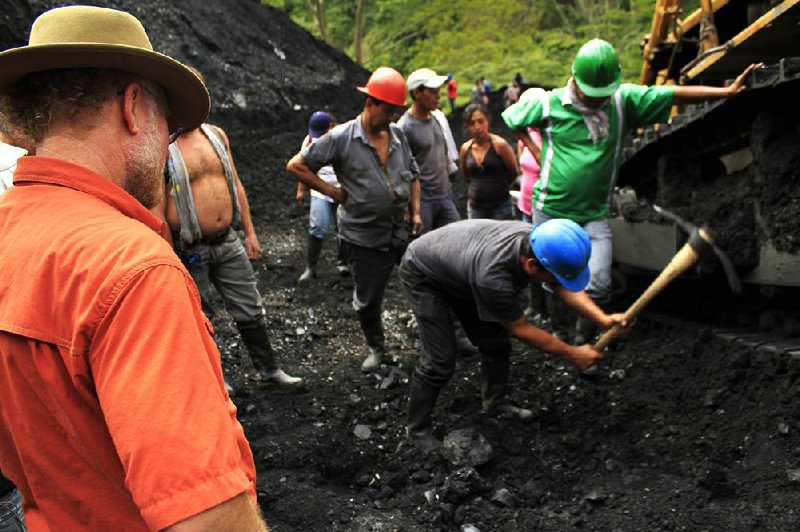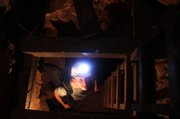HOT SPRINGS — Thomas Nagin has been traveling the world for years, calling it business. When people kept asking if they could go with him, he says, he finally got the idea that what he does might be a fragment out of the ordinary: risking crocodiles and angry gods in search of mineral treasures.
This discovery promises to be the Hot Springs mineral dealer’s biggest yet. Nagin’s new television series, Mineral Explorers, casts the 63-year-old hunter of quartz, emeralds and amethyst as the real thing, a rock star.
“My goal is to show the general public where minerals come from,” he says, “how they’re mined. It’s something most people really don’t know much about.”
The Hot Springs Documentary Film Festival screened the first two episodes of Mineral Explorers earlier this year and last. The half-hour shows follow Nagin and his film making partner, Jonathan Kudabeck, 29, to mines in the South American countries of Colombia and Bolivia.
They find piranha on the menu, razor teeth and all. The fried fish is better than the soup, Nagin reports. They encounter suspicious guards, and they face down the sort of mean-looking guys who stand in the way with machetes.
“Go with a smile,” Nagin recommends, smiling.
He joins in the miners’ custom of offering coca leaves and alcohol to the gods of the underground, hoping the gods will allow them to see daylight again. And he comes up with eye-dazzling chunks and crystals that are millions of years old.
“Art formed by nature,” he says.
Arkansas Educational Telecommunications Network will broadcast the shows as soon as possible, probably next spring, according to Carole Adornetto, director of production. She expects Mineral Explorers will air “repeatedly both in and out of prime time, such is the anticipated interest.”
“As soon as I screened the first episode of Mineral Explorers, I knew it was a winner,” she says. “Thomas is a natural born storyteller. He has an infectious, extraordinary love of his field that translates clearly through the camera lens to the audience. He is funny, intelligent, charming and quite the adventurer.”
Nagin’s expert knowledge of minerals combines with “a touch of Indiana Jones mayhem,” she says - “the ideal program recipe” for the network that promises “Learning never ends.”
Also, Nagin and Kudabeck are in negotiation with the national Public Broadcasting System and National Educational Telecommunications Association to carry and continue the series. They plan at least another four episodes, maybe years’ worth of travels to far-off places in search of sparkle and shine.
“This is something that could take our little film crew all around the world,” Kudabeck says. The crew includes Nagin’s daughter, Karina, production coordinator, and Leslie Fisher, writer and researcher.
ROCK ON
Nagin wears his Indiana Jones-type hat so comfortably, he might as well have the bullwhip to go with it. He shoulders a pickax in the photo on the Mineral Explorers: Colombia DVD cover.
Forty-odd years ago, he worked his own quartz mine near Hot Springs. Some of the quartz that he sells in his Crystal Springs Mining and Jewelry Co. in downtown Hot Springs comes from practically a stone’s throw away.
Arkansas is world-famous for its quartz deposits - so much quartz, people have been mining quartz around Hot Springs and Garland County since the 1800s.
The so-called “common mineral” has many uncommon uses. Quartz goes into clocks and computers, and some people claim it has psychic and healing powers.
“I believe crystal can facilitate healing,” Nagin says. “I think crystal is a conduit,” he says, not a piece of magic in his own experience, but hundreds of people have him told him otherwise.
The quartz hunter’s interest in minerals gradually broadened along with the range of markets he dug up.
He counts among his customers “almost all the major museums” and mineral collectors and home and office decorators. Everybody loves the right rock, it seems to him.
Where else, he wondered, does quartz come from? And what other kinds of crystal might be out there? The answers fill the gallery’s showcases of emeralds, topaz and amethyst, ametrine and citrine, treasures from way down the river, deep in the jungle.
Picked up, too, along the way: silver from Morocco, the jaw of a Russian cave bear, a fossilized crocodile, opal from Australia, dinosaur teeth.
“I make three overseas trips a year, a couple of weeks each,” Nagin says. “I’ve been doing this a long time.”
He sets down the pick to rely on his buyer’s expertise these glittery days. But the mines are remote and the only way to be sure he buys the best is to go see what they’ve got.
“I don’t buy just any old rocks,” Nagin says. “I buy select pieces.”
Here, for example: This 1,000-pound, $50,000 chunk of polished quartz laced with pencil-thin lines of black tourmaline, from Brazil. It stands just inside the door of Nagin’s gallery.
To anyone who ever shelled out for a hunk of quartz at a rock shop, the question is obvious: Having bought this boulder, how do you carry it home?
In a crate, Nagin says, not about to scatter all his secrets like a handful of sparkle dust.
MINES, ALL MINES
Kudabeck is more the frayed jeans and T-shirt look. A Web designer and one-time watch repairman, he hadn’t planned on crawling down any mine shafts.
Their trip to Colombia was the first time Kudabeck had left the United States - “a big learning experience,” he says, ready to go again.
“I had no idea this kind of thing existed,” he says.
As the TV series’ director, he listens to Nagin explain that every crystal has six sides, and further, how crystals form under pressures that people never experience.
Kudabeck weighs how much of this information people really want to know, and what else the audience expects from a TV show.
He argues the need “to mix in adventure and travel.” And from watching other travel shows, he concludes that people aren’t so much interesting in traveling, really, as in what’s to eat when they get there.
Piranha might not be on the table every night under the banana trees. But he knew when he saw it - “the ugliest thing on the menu” - the fish had talent.
DIGGING DEEPER
The pilot episode of Mineral Explorers won the Best Reality Show award at the International Television Festival in Los Angeles, 2011. The second show follows Nagin through the Pantanal wetlands of Bolivia to Anahi Mine for amethyst and ametrine.
Nagin and Kudabeck plan a 12-episode first season that will take them to more and more exotic places on the hunt for minerals and other prizes, adventure and whatever else they might find including:
To Spain for red quartz and yellow fluorite.
To Kenya and Tanzania for blue lace agate and tsavorite garnet.
To Morocco for azurite and fossils.
To India for prehnite, calcite and gemstones.
To Peru for pyrite, hubernite and hutchinsonite.
Nagin thinks over the possibility that television could make his white-and rust beard as famous as chef Gordon Ramsay’s kitchen knife - his travels as much followed as the haggling on Pawn Stars. Viewers might want a cap like Nagin’s that reads “Life is good” or a ring like his, fashioned from an ancient Greek coin.
“It’s not my goal to be famous,” he says. “I just decided that what I was doing was pretty interesting and unusual.
“So I started filming it.” More information about Mineral Explorers and the first two episodes on DVD is available at mineralexplorers.com.
Style, Pages 49 on 11/25/2012

